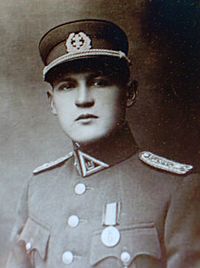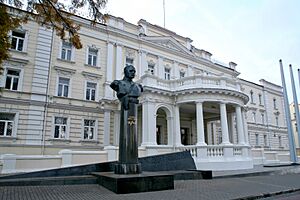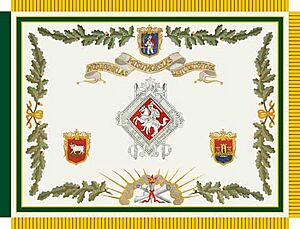Jonas Žemaitis facts for kids
Quick facts for kids
Jonas Žemaitis
|
|
|---|---|
 |
|
| President of Lithuania (Posthumously recognized in March 2009; then Chairman of the Union of Lithuanian Freedom Fighters) |
|
| In office February 16, 1949 – November 26, 1954 |
|
| Preceded by | Antanas Merkys (last head of state before the Soviet annexation in 1940) |
| Succeeded by | Adolfas Ramanauskas (Posthumously recognized in November 2018; then Vice Chairman of the Union of Lithuanian Freedom Fighters) |
| Personal details | |
| Born | March 15, 1909 Palanga, Courland Governorate, Russian Empire |
| Died | November 26, 1954 (aged 45) Moscow, Russian SFSR, Soviet Union |
| Military service | |
| Allegiance | |
| Years of service | 1926–1941 (Lithuanian Army) 1944 (Lithuanian Territorial Defense Force) 1945–1953 (Lithuanian partisans) |
| Rank | |
| Commands | Union of Lithuanian Freedom Fighters |
Jonas Žemaitis (also known by his secret name Vytautas) was a very important leader in Lithuania. He led the armed resistance against the Soviet occupation of his country. Independent Lithuania later recognized him as its head of state. He was born on March 15, 1909, in Palanga and passed away on November 26, 1954, in Moscow.
Contents
Jonas Žemaitis: Early Life and Military Career
Jonas Žemaitis was born to Jonas Žemaitis and Petronėlė Daukšaitė. From 1910 to 1917, he lived with his parents in Łomża, Poland. There, his uncle owned a large dairy farm. Jonas went to primary school in Łomża.
In 1917, his family moved back to Lithuania. They settled in the village of Kiaulininkai. In 1921, he finished his first class at the Raseiniai Gymnasium.
Becoming an Officer
In 1926, Jonas Žemaitis began studying at the War School of Kaunas. He finished this school in 1929 and became a lieutenant. He started his military service as a commander in the 2nd Artillery Battery.
From 1936 to 1938, Žemaitis studied in France. He attended the School of Applied Artillery in Fontainebleau. After his studies, he was promoted to captain. He then commanded artillery units in the Lithuanian military.
Life During Soviet Occupation
After the Soviet Union took over Lithuania in June 1940, Žemaitis continued his army service. He was the head of the school for the 617th Artillery Regiment.
When the war between the Soviet Union and Nazi Germany began, Žemaitis was at a military training ground. He received an order to retreat to the east. However, Žemaitis and some soldiers decided to stay behind. They surrendered to the Germans. He did not want to work for the Nazis. So, he retired from the army and moved to Kaunas. He worked there as a technician.
Leading the Resistance Against Soviet Rule
In 1944, Jonas Žemaitis joined the Lithuanian Territorial Defense Force. This group was put together by Povilas Plechavičius. After the Nazis broke up this force, Žemaitis went into hiding.

When the Soviet army returned to Lithuania, Žemaitis joined the Lithuanian Freedom Army. He also joined the Lithuanian partisans, who were fighting against the Soviets. He quickly became a leader among them.
Forming the Union of Lithuanian Freedom Fighters
In February 1949, Žemaitis created the Union of Lithuanian Freedom Fighters. He became its chairman. His goal was to continue the fight against Soviet occupation. He also wanted to show that the partisans' actions were rightful.
In December 1951, he became very ill and was paralyzed. In May 1953, Soviet agents found his hiding place. He was arrested and taken to Moscow. He was questioned by Lavrentiy Beria. Jonas Žemaitis died in a Soviet prison in 1954.
Jonas Žemaitis: A National Hero
After Lithuania became independent again, Jonas Žemaitis was recognized as a national hero. A monument to him was built in Vilnius, near the Ministry of National Defence. There is also a monument to him in Palanga.
The General Jonas Žemaitis Military Academy of Lithuania is named after him. In 1995, a documentary called Ketvirtasis Prezidentas (The Fourth President) was made about his life.
In March 2009, Jonas Žemaitis-Vytautas was officially given the rank of Brigadier General. He was also officially named the fourth President of Lithuania. This recognition happened after his death.


